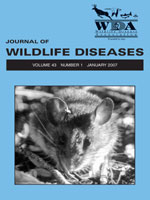Sin Nombre virus (SNV), hosted by the deer mouse (Peromyscus maniculatus), is the principal cause of hantavirus pulmonary syndrome (HPS) in North America. To improve our understanding of factors that contribute to the occurrence of HPS, we conducted an extensive field study of the characteristics of newly infected (as determined by recent acquisition of antibody) deer mice and the temporal pattern of antibody acquisition (seroconversion) from 1994 through 2004 in Montana, USA. We sampled 6,584 individual deer mice, of which 2,747 were captured over multiple trapping periods. Among these 2,747 deer mice, we detected 171 instances of seroconversion. There was no relationship between seroconversion and the acquisition of scars. However, recently infected Montana deer mice were more likely to be older, more likely to be males, and more likely to be in breeding condition. In addition, recently infected male deer mice gained less weight over the 1-mo period following seroconversion than did those that did not acquire antibody, suggesting that SNV infection may have negatively impacted the health of infected rodents. Incidence was highly variable among years, and timing of infections was primarily associated with the breeding season (generally early spring through late fall).
How to translate text using browser tools
1 January 2007
SIN NOMBRE VIRUS INFECTION OF DEER MICE IN MONTANA: CHARACTERISTICS OF NEWLY INFECTED MICE, INCIDENCE, AND TEMPORAL PATTERN OF INFECTION
Richard J. Douglass,
Charles H. Calisher,
Kent D. Wagoner,
James N. Mills

Journal of Wildlife Diseases
Vol. 43 • No. 1
January 2007
Vol. 43 • No. 1
January 2007
antibody
deer mice
epidemiology
Hantavirus
Montana
Peromyscus maniculatus
seroconversion




